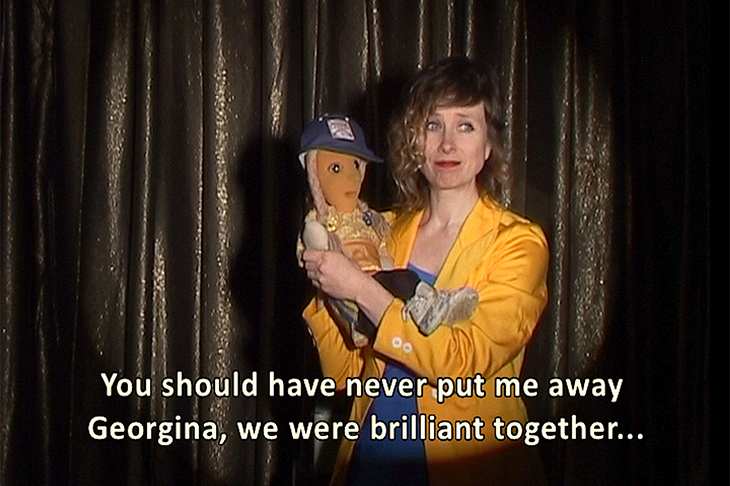As it enters its 40th year, Sheffield’s Site Gallery has taken the opportunity to reflect on the past. For ‘Re-collections’ – the second exhibition in its expanded building, which reopened last September – the gallery has invited three women artists from its exhibition archive to return with work made years after their first show. Each of the three pieces on display also deals with memory, whether that of individuals or more collective histories.
Originally a small photography hub in a suburb of Sheffield, the gallery (then still known as Untitled Gallery) moved to its current location in the city centre in 1988, expanding its remit to moving image, new media and performance. Video is a central element in all three installations in ‘Re-collections’ – by Susan Hiller, Georgina Starr and Elizabeth Price, who worked with the gallery in 1999, 2003 and 2007, respectively. The large exhibition space is divided into three separate rooms, enabling viewers to feel the full force of each work, uninterrupted. In the centre, there is a communal space where snippets of sound from each installation can be heard, like a disjointed collection of memories floating to the surface.
Installation view of The Joyful Mysteries of Junior (2012), Georgina Starr at Site Gallery, Sheffield, 2019. Photo: Jules Lister

In The Joyful Mysteries of Junior (2012), Starr goes on her own trip down memory lane. A recording on a small TV monitor documents Starr’s visit to The Hague in 1994, where Starr – ‘to fight loneliness and entertain myself’ – handcrafted a puppet called Junior, which holds an uncanny resemblance to the artist. Sat on a dingy hotel room floor in front of a video camera, Junior ‘talks’ about being lonely and wanting to leave the city, whilst Starr persuades her of the benefits of staying. Of course, Starr is playing both characters – in creating Junior, she is able to vocalise the contradictory feelings we so often battle with.
Eighteen years later, we watch Starr and Junior reunite and learn a tap dance routine together. Junior scolds the artist for abandoning her; ‘we were great together’, she says. Next to the TV monitor a green suitcase is set against a gold curtain, under a spotlight. The suitcase is recognisable as Junior’s ‘home’ in the video – it’s unclear whether the puppet is currently inside this case. I start to think about what an encounter with my own Junior would entail – what arguments could we have with ourselves about past regrets?
Lost and Found (video still; 2016), Susan Hiller

Hiller’s contribution explores collective memory and how it keeps cultures alive. For Lost and Found (2016) the artist gathered 23 voice recordings of people speaking extinct or endangered languages. We do not see the speakers, instead a green oscilloscopic line translates the sound waves of their voices, reflecting their different intonations. Some participants detail how they have tried to save their language, others recall important moments in their community, while others count, sing or discuss fixing a car.
Hiller’s action of gathering recorded voices is relatively simple, but it also captures the power of language as a vital tool beyond communication. It is integral to heritage and communal identity. It is also immensely political; one speaker recalls being punished for speaking Sauk/Fox (spoken in northern Mexico and the Midwest in the United States) instead of English. What is radical about Lost and Found, Hiller’s last major audio-visual work, is that the artist has guaranteed that fading or faded languages like this are preserved in her museum-like archive forever.
A RESTORATION (video still; 2016), Elizabeth Price. Courtesy the artist and MOT International London and Brussels

The role of archives in remembering is Price’s main concern in her work, A RESTORATION (2016). The two-channel video features a captivating collage of images and objects in the collections and archives of the Ashmolean and the Pitt Rivers museums in Oxford. Electronic music drives the piece forward as a robotic voiceover takes us on a poetically worded tour of these archives, asking if there might be a new way to organise all this history. The work throws up all sorts of questions about how we attach value to objects and the position of museums in preserving the traditions of civilisations.
In looking to its own past, Site Gallery’s exhibition also asks us to question the ways in which we remember. Together, the three works in ‘Re-collections’ interrogate the methods that we so often rely on – whether that be our own inner monologues, the traditions of communities, or the authority of museums.
‘Re-collections: Susan Hiller, Elizabeth Price, Georgina Starr’ is at Site Gallery, Sheffield, until 19 May.



